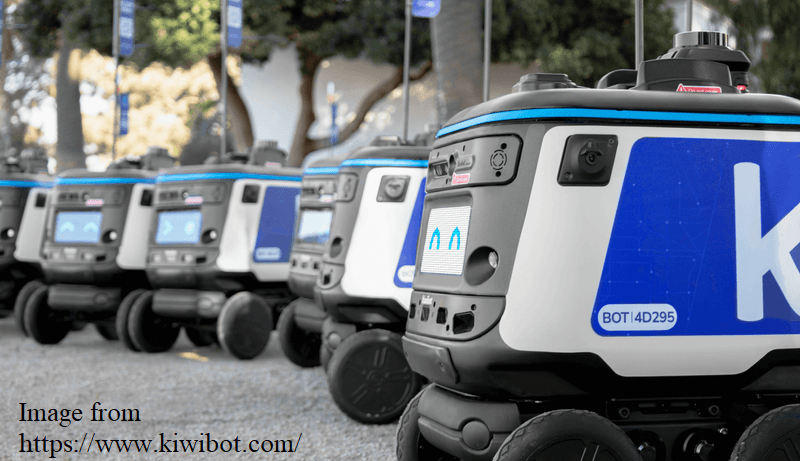Industry News
Customs Rules that Robots are Trucks (?!?)
TweetJun. 19, 2023
By:
David G. Forgue
In a ruling dated June 7, 2023, Customs addressed the classification of meal and product delivery robots, specifically the Kiwibot. The importer had sought classification of the robots as work trucks under HTS heading 8709. Customs disagreed, with potentially drastic consequences for the emerging warehouse/factory robotics industry.

The Kiwibot is described thus:
The subject merchandise consists of meal and product delivery robots from Colombia known as “Kiwibots.” You state that the robots are “aimed at universities, cities, and companies in general,” and that they “circulate safely along the sidewalks to deliver meals and products through customers using an API (Application Programming Interface).” This API allows customers and users to connect to the robot and track their orders “at all times.” The robots use artificial intelligence, machine learning, and deep learning, and can “partially modify their speed autonomously on sidewalks based on the proximity of people.” To communicate with their surroundings, the robots have digitally animated eyes and can play sounds.
You further state that the robots have an inner plastic container for placing meals and products. Each robot incorporates electric hub motors to self-propel. The robots contain five distance sensors for avoiding obstacles, as well as a set of four cameras, a “Real Sense” camera, a GPS, and antennas. Finally, you note that “[o]ccasionally, a Kiwibot must operate on a public road, and in those circumstances, Kiwibot [i.e., Kiwi Campus, Inc.] obtains an operating permit from the appropriate State authority.”
One can understand why the importer believed HTSUS heading 8709 would be the appropriate heading. Heading 8709 covers “works trucks, self-propelled, not fitted with lifting or handling equipment, of the type used in factories, warehouses, dock areas or airports for short distance transport of goods; tractors of the type used on railway station platforms.” The robot is definitely self-propelled, does not have lifting or handling equipment, and is of a type that could be used for short distance delivery in factories, warehouses, and similar environments. Regardless of whether these robots are intended to make deliveries on campuses, the tariff language talks about articles “of a type that could be used . . .” In other words, the tariff language is less focused on this actual use than the type of article in question.
Heading 8709 seems even more appropriate when the Explanatory Notes (“ENs”) are reviewed. The ENs describe characteristics work trucks have as
(1) Their construction and, as a rule, their special design features, make them unsuitable for the transport of passengers or for the transport of goods by road or other public ways.
(2) Their top speed when laden is generally not more than 30 or 35 km/h.
(3) Their turning radius is approximately equal to the length of the vehicle itself.
Vehicles of this heading do not usually have a closed driving cab, the accommodation for the driver often being no more than a platform on which he stands to steer the vehicle. Certain types may be equipped with a protective frame, metal screen, etc., over the driver’s seat.
The subject articles were definitely unsuitable for the transport of passengers or goods by road or other public ways. There is literally nowhere for passengers to sit. The Kiwibot also lacks any indication of being street legal, without headlights, turn signals, brake lights, or other indicia of road use. Similarly, the Kiwibot seems unlikely to travel faster than 35 km/h (about 22 mph).
Finally, Customs has previously ruled that a seemingly similar article called the Automated Trackless Robotic Courier: Pyxis HelpMate® SP was classified under HTS heading 8709.
However, Customs was not persuaded by these apparent factors in support of classification under heading 8709. Instead, Customs decided that the imported articles were more properly classified under HTS heading 8704 as a motor vehicle for the transport of goods. This decision appears to be part of an emerging line of classifications in which electric vehicles that appear similar to 8709 work trucks are classified as motor vehicles for the transport of goods. N327126 (August 11, 2022) applies similar logic, but to a drivable vehicle. The Kiwibot ruling appears to be the first application of this reasoning to a driverless robot.
The classification under heading 8704 comes with a number of complications. First, the terms of HTS heading 8709 appear to describe robots of this type. Therefore, under GRI 1 we would normally expect robots of this type to be classified under heading 8709. As Customs applied the language of 8709 the same robot marketed for use inside of warehouses might be classified differently. Second, the general Column 1 tariff rate for goods under heading 8704 is 25%. This is a prohibitively high tariff rate for an emerging technology. Third, motor vehicles of Heading 8704 and their parts are subject to an array of regulations under the United States Mexico Canada Agreement (“USMCA”) and other United States free trade agreements. While the goods from Colombia face a lower regulatory burden, robots made anywhere in North America to be marketed in North America face the onerous USMCA automotive regulations. Those USMCA regulations were negotiated with automotive manufacturing in mind, not small robots.
While it remains to be seen whether this line of rulings will be challenged, the reality is that unless and until it is, increasingly common technology used to deliver parcels, food, articles within warehouses and factories, and similar tasks will face high tariffs, high free trade agreement bars for duty free qualification, and treatment under legal regimes never intended for such articles.
If you have any questions about tariff classification or getting a ruling from Customs (and potentially litigating that result) do not hesitate to contact any attorney at Barnes, Richardson & Colburn, LLP.
